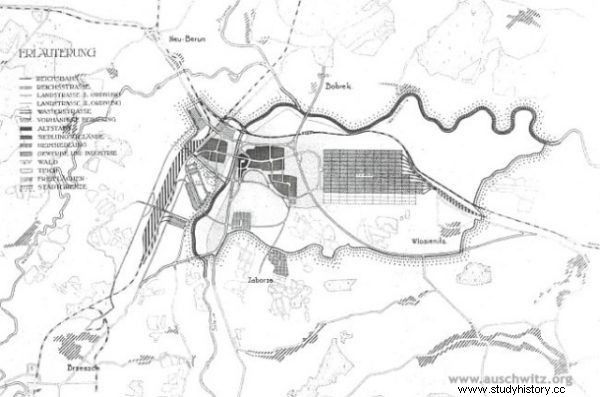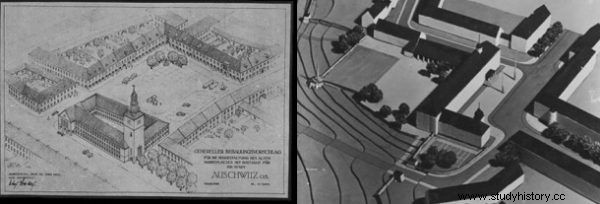The first association with Auschwitz of the Second World War? Concentration camp. Second association? Also the camp. And the third is the same. Certainly, the Nazi officials, architects and colonists had a different opinion. For them, the camp a few kilometers from the square was of no importance. After all, they were building the perfect German city!
It can be assumed that Polish Oświęcim ceased to exist in the spring of 1941 and was replaced by Auschwitz. It was then that the Germans completed the process of deporting residents, as a result of which only 7,600 people remained in the town. 90% of them were Poles, but they were relegated to the role of a temporary working class.
Only the Germans and the Volksdeutsche could consider themselves citizens of Auschwitz - and at first there were only 820 of them. .

Plan of the "Great Auschwitz" with an outline of the communication system.
On the occasion of the construction of a synthetic rubber factory by IG Farben, Auschwitz itself was to be thoroughly Germanized and become an example of an exemplary transformation - from a Polish, backward hole into a truly Aryan center! Or even:an ideal Nazi city.
Initially, it was primarily about providing comfort to German workers and engineers brought from other regions. New employees of the rubber factory were to be found in Auschwitz:
every possible convenience , spacious, well-equipped in terms of quality and child-friendly apartments, as well as places for comprehensive sports and recreation (this is what Sybille Steinbacher describes in her book "Auschwitz. Obóz i Miasto", p. 69) .
For this purpose, it was intended to completely rebuild the urban fabric. The new authorities planned the construction of 1,600 "people's flats" ranging from 40 to 60 square meters, as well as a series of single-family houses with garages and gardens.

Stosberg's plans:on the left, a new "Aryan" market; on the right, another fragment of the model of the great Auschwitz.
All properties were to have central heating, running water, gas valve, laundry, etc. Some of these ideal flats for German families were actually built and today they are part of Oswiecim's Chemists' Estate.
However, the plans were budding at a pace that no construction could keep up with! The main designer of the new Auschwitz was a certain Hans Stosberg - an influential Wrocław architect, who quickly got carried away by… mania for grandeur. While initially it was about the construction of a comfortable housing estate, after a few months the plans started talking about the construction of two completely new districts and several "satellite estates" .

Stosberg intended to demolish the parish church, lead a wide street through the center of the city, and erect: Twelve schools, six kindergartens, 20 playgrounds and several stadiums with swimming pools and sports fields (p. 73). In addition, in the place previously occupied by the Jewish cemetery, a party house with a hotel, cinema and restaurant was to be located.
With each successive month, the scale of plans grew. In June 1941, Stosberg predicted that Auschwitz would eventually have 30,000 inhabitants (more than twice as many as before the war). After just a few months, it was 40,000, then 60,000, and finally - in the project from January 1943 - even 80,000 inhabitants!
Fortunately, the whole ideal Aryan city on the ruins of a Polish town did not have time to rise. The absurd plans for its construction say one thing above all:that the Germans did not mind the proximity of the largest death factory in history at all. And they were not going to be ashamed of Auschwitz at all.
Source:
Trivia is the essence of our website. Short materials devoted to interesting anecdotes, surprising details from the past, strange news from the old press. Reading that will take you no more than 3 minutes, based on single sources. This particular material is based on:
- Sybille Steinbacher, Auschwitz. Camp and town , Polish Scientific Publishers PWN, 2012.
